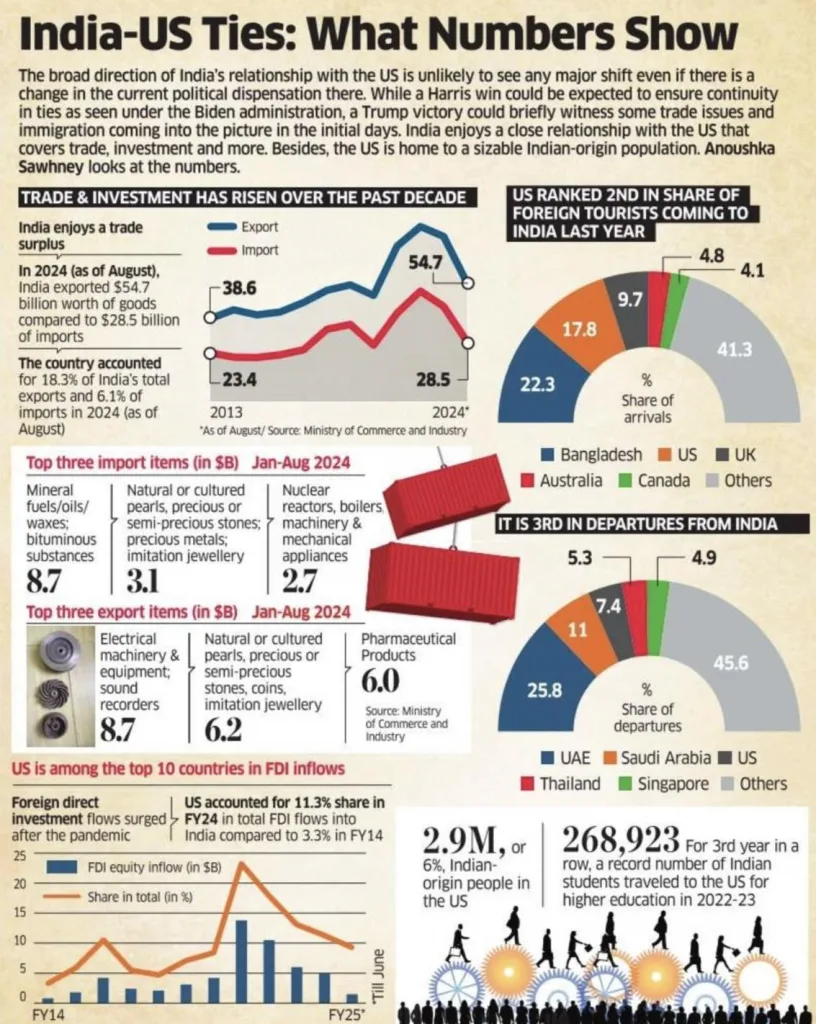Syllabus: GS2/International Relation
Context
- With Donald Trump securing a second term as President of the United States ‘Trump 2.0’, the dynamics of US-India trade relations are poised for significant shifts with renewed focus on his ‘America First’ policies, which are expected to impact various sectors of the Indian economy.
Importance of India-US Relations
- The relationship between India and the United States has evolved into one of the most significant partnerships in the 21st century. It spans economic, strategic, and cultural dimensions, reflecting the shared values and mutual interests of the world’s largest democracies.
Strategic Interests:
- The two nations are motivated by common interests: India aims to become the world’s third-largest economy, while the US seeks reliable allies to counterbalance China’s growing influence.
- Their shared focus on economic growth and security can lead to deeper co-operation in areas like counterterrorism and Indo-Pacific stability.
- Defence and Security: Trump’s emphasis on reducing US involvement in foreign conflicts might push India to take a more prominent role in regional security.
- It could lead to increased defence collaborations and arms deals, bolstering India’s military capabilities.
- There could be increased cooperation in technology and defence, with the US likely to open up more military hardware for Indian defence forces.
Economic Interests:
- Both India and the US share a pro-business stance and a focus on economic growth, which could drive substantial changes on the global economic stage.
- Trump’s ‘America First’ policy, while often seen as isolationist, aligns with Modi’s ‘Make in India’ initiative, potentially fostering deeper economic ties.
- The Trump administration is expected to revive negotiations for a Free Trade Agreement, which had seen intense discussions during his first term.
- The growth of Global Capability Centres (GCCs) in India, driven by US companies, is one such area where collaboration could flourish.
- Under Trump 2.0, India might face trade skirmishes, but it is better prepared today with export-friendly policies like the Production Linked Incentive (PLI) scheme and the semiconductor program.
Trade Policies:

- Trump’s protectionist stance, including higher tariffs on imports, could pose challenges for Indian exporters. During his first term, Trump was vocal about reducing the trade deficit with countries like India.
- Trump’s unpredictable policy shifts could create economic instability. For instance, changes in trade agreements or sanctions on countries like Iran could disrupt India’s energy supplies and increase costs.
- For India, this could complicate trade relations, especially in sectors like IT, pharmaceuticals, and textiles, which rely heavily on the US market.
- His administration imposed tariffs on several Indian goods, and similar measures could be expected in his second term.
Immigration Overhaul: Deportations and Visa Restrictions:
- Stricter immigration laws could impact the Indian workforce in the US, particularly in the tech sector. With Trump 2.0, there is a likelihood of further restrictions, which could impact the flow of skilled Indian professionals to the US.
- The already difficult process for legal migration to the US, particularly through the H-1B visa program, will likely become even more restrictive under his administration.
Energy Policies:
- Trump’s energy policies, which favour fossil fuel production, could lead to lower global oil prices.
- It might benefit India, a major oil importer, by reducing its import bill.
- However, it also poses challenges for global climate change efforts, an area where India has been making significant strides.
Global Implications
- Trade Wars and Global Economy: The return of Trump’s aggressive trade policies could reignite trade tensions with major economies like China and the European Union.
- It could disrupt global supply chains and impact economic stability worldwide.
- For emerging economies like India, navigating these tensions will be crucial to maintaining growth.
- Geopolitical Dynamics: Trump’s foreign policy, marked by unpredictability and a transactional approach, could alter geopolitical alliances.
- For India, this means balancing its strategic partnership with the US while managing relations with other global powers like China and Russia.
- Climate Change and Sustainability: Trump’s scepticism towards climate change and his support for fossil fuels could slow down global efforts to combat climate change.
- It is a significant concern for India, which is vulnerable to climate impacts and has been actively working towards sustainable development goals.
Opportunities Amid Challenges
- Despite the challenges, there are potential opportunities for India. As Trump seeks to reduce reliance on China, new trade opportunities could emerge for India to attract American firms looking to diversify their supply chains away from China.
- India, with its growing economy and strategic importance, might leverage this to negotiate favourable terms in areas like defence, energy, and technology.
- The strategic alignment on counterterrorism and Indo-Pacific stability offers significant opportunities for collaboration.
Conclusion and Future Outlook
- Trump’s second term is a mixed bag for India. Trumponomics, with its blend of protectionism and pro-business policies, presents a complex landscape for India and the world. While there are opportunities for economic growth and investment, the challenges of trade tensions, energy policies, and climate change cannot be overlooked.
- As India navigates this new phase, strategic diplomacy and adaptive economic policies will be key to leveraging the benefits and mitigating the risks of Trump’s second term.
- While there are opportunities for strategic gains, particularly in defence and bilateral relations, the economic challenges cannot be overlooked.
| Daily Mains Practice Question [Q] Analyse the recent developments in India-US relations. Do you believe they signify a new era in bilateral ties? Discuss the key factors driving this transformation and its potential implications for the global geopolitical landscape. |
Previous article
BRICS & India-Iran Ties
Next article
India, Pakistan, & Modifying the Indus Waters Treaty